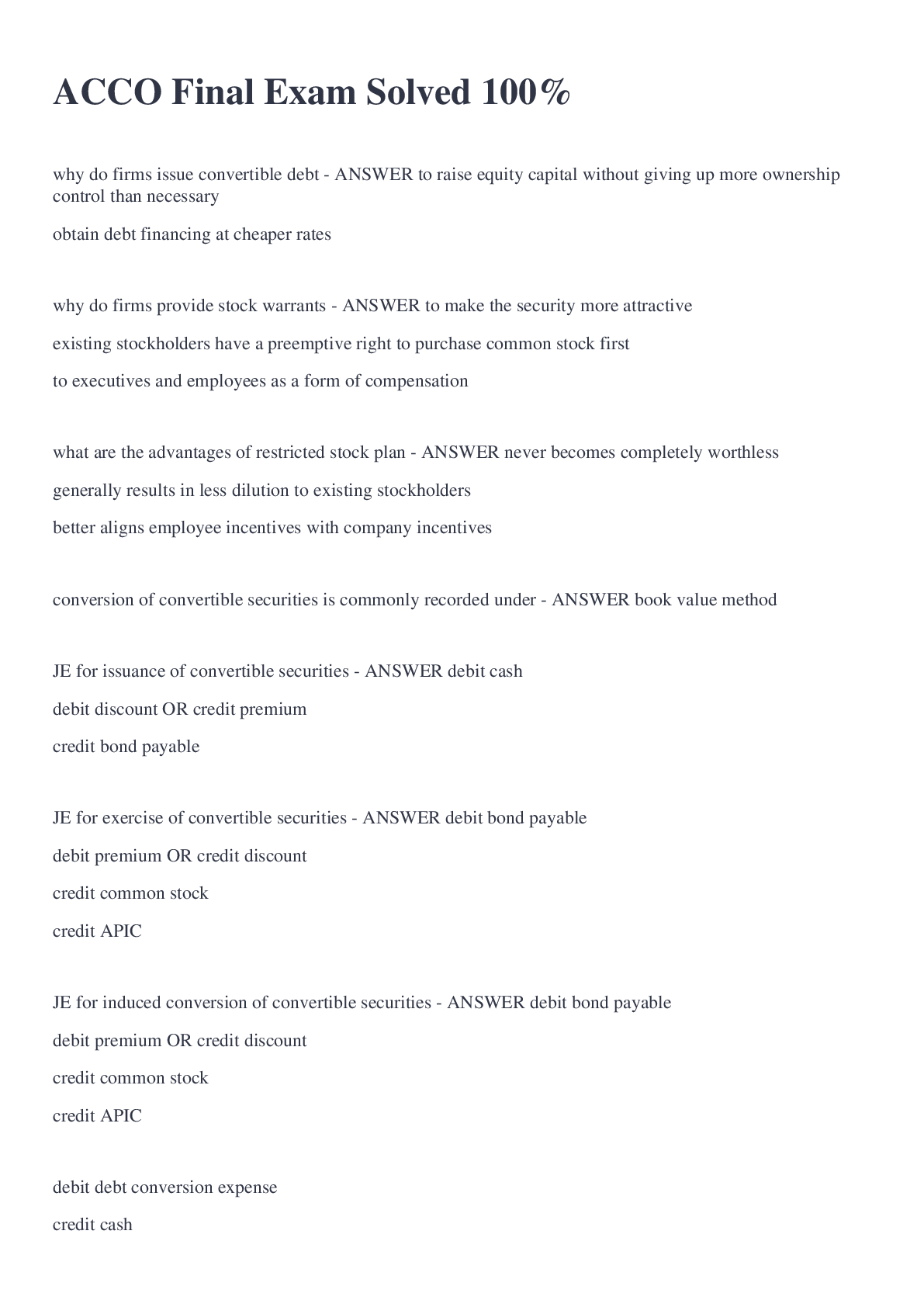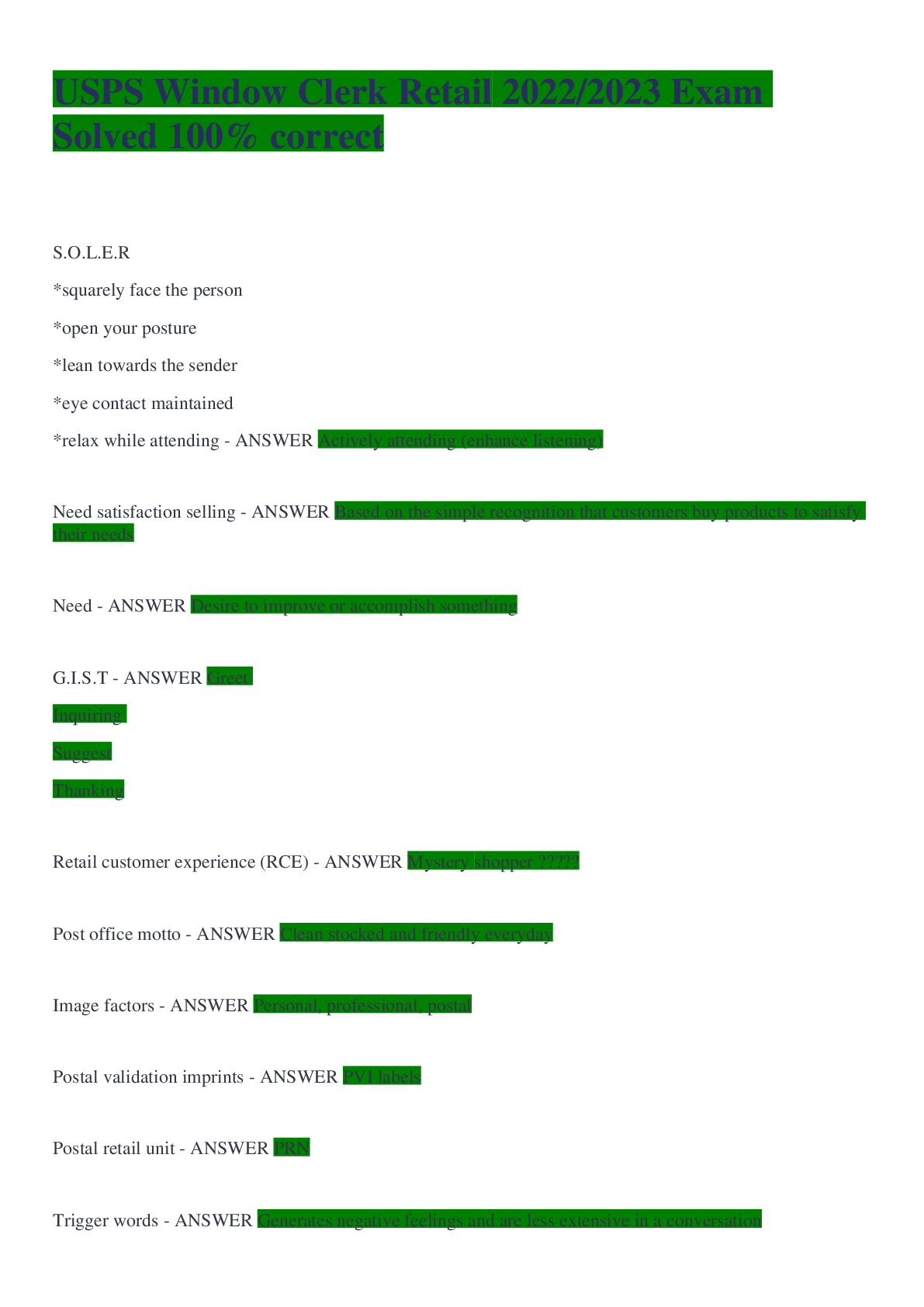Financial Accounting > EXAM > ACCO Final Exam Solved 100% (All)
ACCO Final Exam Solved 100%
Document Content and Description Below
why do firms issue convertible debt - ANSWER to raise equity capital without giving up more ownership control than necessary obtain debt financing at cheaper rates why do firms provide stock warra... nts - ANSWER to make the security more attractive existing stockholders have a preemptive right to purchase common stock first to executives and employees as a form of compensation what are the advantages of restricted stock plan - ANSWER never becomes completely worthless generally results in less dilution to existing stockholders better aligns employee incentives with company incentives conversion of convertible securities is commonly recorded under - ANSWER book value method JE for issuance of convertible securities - ANSWER debit cash debit discount OR credit premium credit bond payable JE for exercise of convertible securities - ANSWER debit bond payable debit premium OR credit discount credit common stock credit APIC JE for induced conversion of convertible securities - ANSWER debit bond payable debit premium OR credit discount credit common stock credit APIC debit debt conversion expense credit cash how to determine value of stock warrants on issuance date - ANSWER proportional method: # * $ * % + # * $ --> # * $ * og % and split by proportion incremental method: same vibe but without fair value JE stock warrant issuance - ANSWER debit cash credit PIC warrants JE stock warrant exercise - ANSWER debit cash debit PIC warrants credit common stock credit APIC common stock stock option is valued based on - ANSWER option pricing models under fair value method compensation expense should be allocated over - ANSWER service life JE employee stock option - ANSWER date of grant: none compensation expenses: debit compensation expense credit PIC stock option date of exercise: debit cash debit PIC stock option credit common stock credit APIC common stock date of expiration: debit pic stock option credit pic expired stock option JE restricted stock - ANSWER date of grant: debit unearned compensation credit common stock credit APIC common stock compensation expense over time: debit compensation expense credit unearned compensation if employee leaves before service requirement met: debit common stock debit APIC common stock credit compensation expense credit unearned compensation how to calculate weighted average shares - ANSWER dates outstanding - periods shares outstanding - shares # without calculations restatement - (1 + stock dividend %) fraction of year - # of months / 12 weighted shares - shares outstanding * restatement * fraction weighted average # - add all together how to calculate EPS - ANSWER (NI-preferred shares)/ WA shares deferred tax asset - ANSWER increase in taxes refundable (or saved) in future years as a result of deductible temporary differences existing at the end of the current year less tax in future higher tax today future deductible expenses or losses are deductible after they are recognized in financial income revenues or gains are taxable before they are recognized in financial income deferred tax liability - ANSWER expenses or losses are deductible before they are recognized in financial income revenues or gains are taxable after they are recognized in financial income increase in taxes payable in future years as a result of taxable temporary differences existing at the end of the current year higher tax in future less tax now future taxable amounts temporary vs permanent differences - ANSWER temporary: difference between tax basis of an asset of liability and its reported amount in the financial statements that will result in taxable amounts or deductible amounts in future years only temporary differences reverse in future years permanent: result from items that enter into pretax financial income but never into taxable income or enter into taxable income but never into pretax financial income affect only the period in which they occur do not give rise to future taxable or deductible amounts no deferred tax consequences to be recognized *both will cause a difference between taxable amount and pre-tax financial income deferred tax liability JE - ANSWER current period (pretax > taxable): debit income tax expense credit income tax payable credit DTL future period (pretax < taxable): debit income tax expense debit DTL credit income tax payable deferred tax asset JE - ANSWER current period (pretax < taxable): debit income tax expense debit DTA credit income tax payable future period (pretax > taxable): debit income tax expense credit income tax payable credit DTA order of tax JEs - ANSWER 1. income tax payable (tax rate * (financial income - temp difference)) 2. DTA or DTL (sum of (taxable amounts * tax rate)) 3. income tax expense (plug) what tax rate should be used for DTA and DTL - ANSWER in determining the appropriate enacted tax rate for a given year, companies must use the average tax rate JE related to NOL carryforward - ANSWER NOL = tax deductible expenses > taxable revenues debit deferred tax asset credit benefit due to loss carry forward defined contribution - ANSWER employer contribution determined by plan risk borne by employees benefits based on plan value each time period, contribute % defined benefit - ANSWER benefit determined by plan employer contribution varies (determined by actuaries) risk borne by employer guaranteed to receive certain amount of income 3 alternative measures for pension obligation - ANSWER vested benefit obligation: benefits for vested employees only at current salaries accumulated benefit obligation: benefits for nonvested employees at current salaries projected benefit obligation: benefits for vested and nonvested employees at future salaries plan asset - ANSWER assets that have been segregated and restricted to provide for pension benefits projected benefit obligation - ANSWER include both vested and nonvested years of benefits at current salary level overfunded - ANSWER fair value of plan assets > PBO underfunded - ANSWER fair value of plan assets < PBO components of pension expenses - ANSWER service cost: increase pension expense caused by increase in PBO to employee due to service present value of new benefit earned by employee during year interest on liability: increase pension expense accrued each year on PBO using settlement rate actual return: generally decrease pension expense accumulated return interest and dividend accumulated within fund and changes fair value of fund assets (plan asset end FV - plan asset begin FV) - (contributions - benefit paid) amortization of PSC: generally increase pension expense allocate cost of providing retroactive to pension expenses in future service year or straight line gains/losses: liability g/l - changes associated with unexpected changes in fair value of plan asset and changes in PBO recorded as OCI to limit growth of accumulated OCI, corridor amortizes OCI's balance when its 10% of larger balance actual return - expected return = unexpected g/l amortize service costs for prior years - service year method - ANSWER employees in each column add up totals subtract each total from each year multiply by cost and total up amortize service costs for prior years - straight line - ANSWER service years / total employers annual expense / ^ corridor method - ANSWER amortizes net gain or loss balance when its too large 10 % of bigger number between PBO and plan assets pension expense JE - ANSWER use worksheet benefits of leasing for lessee - ANSWER 100% financing at fixed rates protection against obsolescence flexibility less costly financing benefits of leasing for lessor - ANSWER often provides profitable interest margins can stimulate sales of lessor's product provides tax benefits to various parties in lease provide high residual 5 steps for lease classification - ANSWER transfer of ownership: lease transfers ownership of asset to lessee purchase option: allows lessee to purchase property for price that is significantly lower than underlying asset's expected fair value at the date the option becomes exercisable lease term (75%): if 75% or greater of economic life of leased asset PV: sum of lease payment and any lessee residual value guaranteed by lessee not reflected in lease payment = or > all underlying fair value (90%) lease payment: fixed or variable, guaranteed residual value, payments related to purchase or termination options that lessee reasonably certain to exercise discount rate: implicit interest rate (desired rate of return that lessor has in mind when deciding lease payment size) alternative use: lessee uses all benefits from leased asset and they essentially purchased asset both finance and operating leases should be - ANSWER capitalized [Show More]
Last updated: 2 years ago
Preview 1 out of 15 pages

Buy this document to get the full access instantly
Instant Download Access after purchase
Buy NowInstant download
We Accept:

Reviews( 0 )
$8.00
Can't find what you want? Try our AI powered Search
Document information
Connected school, study & course
About the document
Uploaded On
Oct 20, 2022
Number of pages
15
Written in
Additional information
This document has been written for:
Uploaded
Oct 20, 2022
Downloads
0
Views
83





















